-

新人教版高中英语必修2Unit 4 History and Traditions-Discovering Useful Structure教案二
This teaching period mainly deals with grammar: The past participle is used as attributive and objective complement.1. Guide students to review the basic usages of the past participle used as attributive and objective complement.2. Lead students to learn to use some special cases concerning the past participle used as attributive and objective complement flexibly.3. Strengthen students’ great interest in grammar learning.1. Help students to appreciate the function of the past participle used as attributive and objective complement.2. Instruct students to write essays using the past participle used as attributive and objective complement.Step1:温故而知新。Analyze the underlined phrases and then sum up the common usages of the past participles.1.(教材P41)They had castles built(build) all around England, and made changes to the legal system.2.(教材P42)They use the same flag, known(know) as the Union Jack,...3.(教材P42)Judy and I had our car parked(park) in an underground car park near Trafalgar Square, where we could get our car battery charged(charge).Common points: f the past participle used as attributive and objective complement.Step 2:过去分词作定语时的意义1.及物动词的过去分词作定语,在语态上表示被动;在时间上,常表示动作已经发生或完成,有时也不表示时间性。Our teacher watched us doing the experiment and gave us a satisfied smile at last.我们的老师看着我们做实验,最后给了我们一个满意的微笑。The plan put forward at the meeting will be carried out soon.会上提出的计划将很快被执行。2.不及物动词的过去分词作定语,它不表示被动意义,只强调动作完成。Many little kids like gathering fallen leaves in the yard.

新人教版高中英语必修2Unit 4 History and Traditions-Reading and Thinking教案二
Step 5 While reading---Task 3Read the text again and answer the following questions.Q1: How many countries does the UK consist of ?4 Q2: What are the four countries of the United Kingdom?England, Wales, Scotland and Northern Ireland Q3: Which two were the first to be joined together ?England and WalesQ4: What are the two chief advantages of studying the history of a country ?The first one is to help you understand more about the country and its traditions.The second one is to make visiting it more enjoyable.Q5: What’s the author’s attitude towards studying the history ?Supportive/positiveStep 6 Post reading---Retell the textThe United Kingdom, Great Britain, Britain, England—many people are confused by (1)_____ these different names mean. In the 16th century, the nearby country of Wales (2) __________(join) to the Kingdom of England. In the 19 th century, the Kingdom of Ireland was added to create the United Kingdom of Great Britain and Ireland. Finally, the southern part of Ireland (3) ______ (break) away from the UK, which resulted in the full name we have today. However, most people just use the (4)_________(shorten) name: the UK. The four countries (5)__________ belong to the United Kingdom work together in some areas. There were four sets of invaders and the last group were the Normans. They had castles (6)_________(build) all around England and made changes (7)__________ the legal system. Studying the history of the country will make your visit much more (8)_________(enjoy). The capital city London is (9)___ ancient port city that has a history (10)______(date) back to Roman times. 1. what 2.was joined 3.broke 4.shortened 5.that 6. built 7.to 8.enjoyable 9.an 10.dating Step 6 Homework

新人教版高中英语必修2Unit 4 History and Traditions-Listening&Speaking&Talking教案二
Listening and Speaking introduces the topic of “Take part in a youth project”. The listening text is an interview about "sharing views on historical sites". Through listening to a dialogue between Chinese and foreign students on the way to the Confucius Temple, students can understand their views on the Confucius Temple, Confucius, Confucius' descendants and Confucius' educational thoughts, so as to realize and think about the profound influence of Confucius and his thoughts on Chinese historical tradition. At the same time, the dialogue naturally integrates English idioms and mentions Shakespeare, the British playwright, so as to provide language materials and context for students to understand English idioms and related cultural allusions, as well as to compare Chinese and foreign cultures, which is helpful for students to understand and express the language such as history, tradition, culture and custom significant impact.Text analysis: listening text is a dialogue between a British student and a Chinese student when he goes to the Confucius Temple. When William, a British student, visited the Confucius Temple, he asked Xiao Kong, a Chinese student, for directions. Xiao Kong was just going to the Confucius Temple to meet with the members of the research group, so they went together and exchanged their views on the Confucius Temple, Confucius, Confucius' descendants and Confucius' educational thoughts. From the perspective of foreign tourists, this paper describes their thoughts on Confucius, the great son of Confucius, who had a profound impact on Chinese history and cultural tradition, and his education.Listening and Talking introduces a visit to a historic tourist destination. Tourism is a common way to understand a country's history, culture, and customs and so on. Students listen to the dialogue between Xiao Yan, a youth hostel Usher, and Paul, a backpacker, to learn about Pingyao's famous historical and cultural attractions and Paul's travel experience and experience as a foreign tourist.

新人教版高中英语必修2Unit 5 Music-Discovering Useful Structures教案二
4. When he got absorbed in his world of music, he felt as if he could “see” the beauty of the world around him, like he had in his previous life.P·P as adverbial: _________________________________________________________________.Function: _______________________________________________________________________.Step 5 Solid Complete the passage with the words in brackets in their correct forms.Well known as a successful band, the Impact members show quite a few striking qualities. They never ever give up. When _____________(question) by the media, they are not _____________(discourage) and practise even harder. They are improving themselves by attending several master training class. They are united. _____________(fill with) team spirit, they act as a whole, always aiming for glory. Step 6 Difference and similarity from -ingObserve the following examples.1. He went out, shutting the door behind him.=He went out, ________________________________________________________.2. Not knowing what to do, he went to his parents for help.=__________________________________________, he went to his parents for help.Similarity: _______________________________________________________________________________________________________________________________________________________.Difference : _______________________________________________________________________________________________________________________________________________________.Step Practice1. ________ in a hurry, this article was not so good. 因为写得匆忙, 这篇文章不是很好。2. ________ carefully, he found something he hadn’t known before. 他仔细读书时, 发现了一些从前不知道的东西。3. ________ why he did it, the monitor said it was his duty. 当被问及他为什么要这么做时, 班长说这是他的职责

新人教版高中英语必修2Unit 5 Music-Reading and Thinking教案二
1. Get basic information about Eric; read deeply to understand the history and development of the virtual choir.2. Understand what the function of the virtual choir is and how to make a virtual choir.3. Understand the meaning of some languages in the context of the text through question guidance, such as “Many people do not have close friends or contacts who have the same interest in music.” and so on.Step 1 Leading-in1. Answer the following questions.Q1:Do you know the Apps like Tik Tok and Quick Hand?Q2: Do you want to make a Tik Tok video or a Quick Hand video?2. Play a Tik Tok video Step 2: Understanding the title Q1:What does the title mean ?Q2: Is the article a narration or exposition? Why? Q3: Can you change the title ? If you can, what is the title?Step 3: Scanning the whole text and getting the basic information1. Answer the following questions.Q1:Who came up with the idea for a virtual choir?Q2: Where did Eric studied the musical composition?Q3: What is his song?2. Find the main idea of each paragraph3. Deal with some new words.Step 4: Reading carefully to get detailed informationPara 1 How to make a virtual choir1. PreparationA. tools: a virtual camera; an Internet connectionB. hero/heroin: friends or some individuals who have the same interests2. Process
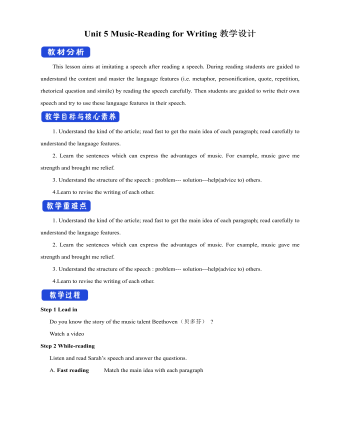
新人教版高中英语必修2Unit 5 Music-Reading for Writing教案二
The Internet celebrity Gao Yifeng. Years ago, he owned 5 companies and the staffs over 1,000, but during the economy crisis, he became nothing but debt. He was so worried that his hair became white overnight. There was a time when he wanted to killed himself. But after listening to the song Start Over by Liu Huan, he decided to cheer himself up. He started a steamed bun shop and gradually became a national chain shops. Now he became successful again.Walter Haddon said, “Music is the medicine of a troubled mind.” Music contains such a pleasant and inspiring force. Music gave him courage and bravery. When he listened to the song, it made his spirit fly like a kite in the wind. Music gave him strength and brought him relief. It was the rock I leant on to become strong and to get through those hard times. I hope none of us have to go through the same kind of suffering that he did. At the same time, we all go through various periods when we feel sad or alone. During those times, music can help us in the same way that it helped him. I hope we all will somehow begin to treasure music and make it a part of our life. Thank you for your listening !5.Revise your writing each other.Does he/she explain how music has changed his/her/someone else’s life?Are some of the rhetorical devices included and used properly ?Does he/she talk about how music makes him/her/someone feel?Is the first word in each sentences capitalised?Does he/she use correct punctuation ?
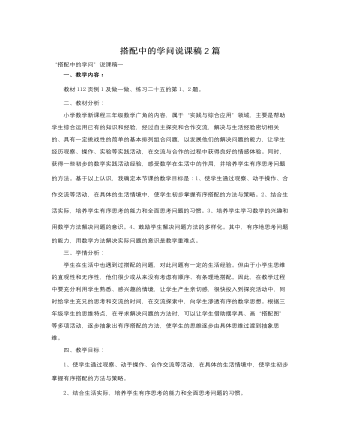
人教版新课标小学数学三年级上册搭配中的学问说课稿2篇
师:同学们真聪明,小精灵的问题回答出来了,现在就让我们一起走进儿童乐园吧。(出示课件)请大家注意观察,儿童乐园中都有哪些景点?师:从儿童乐园出发经过百鸟园去猴山一共有几条路?请同学们仔细观察:从儿童乐园到百鸟园有几条路?从百鸟园去猴山有几条路?(生回答。)师:我们给这5条路分别标上序号。(课件演示)现在请同学们想一想从儿童乐园的入口经过百鸟园到达猴山一共有几条路线?请同学们把答案写在记录纸上。(生汇报。)师:路线设计好了,让我们一起到猴山看一看可爱的小猴子吧!(放猴山的录像。)师:看,它们是一对著名的动物小明星,会演杂技的小猴宝宝和贝贝,你们想和它们照相留念吗?生:想。师:好!那我们每个人都和宝宝、贝贝各照一张相片,同学们想一想,我们全班40个人一共要照多少张相片儿呢?
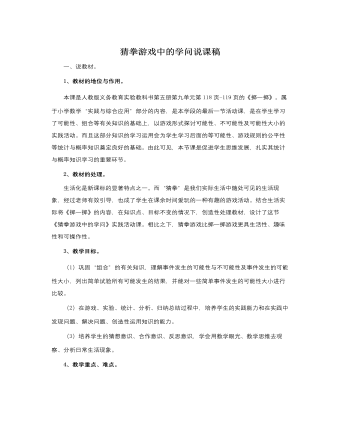
人教版新课标小学数学三年级上册猜拳游戏中的学问说课稿
想一想:为什么在师生猜拳中老师一直说“5”能赢?为什么选择和多的那队没胜,而选择和少的那队却胜了?选择可能性大的是不是每次一定能赢?选择可能性小是不是每一次一定都输?(至此,本节课到了一个升华层次,学生通过互动游戏、自主探究、讨论分析,从而揭示了“猜拳游戏”中的秘密,对“可能性”的理解达到了一个更高水平,有效地完成了本课重难点教学。)(4)实践验证。实践验证理论。再一次组织学生有目的地猜和,进行实践验证。让理论与实践有机的结合(三)拓展创新,内化提升。儿童用品商店将要举行促销活动,凡到商店购物的顾客都可参加《转盘转转乐》活动。每位顾客可转两次,用两次指针所指数相加得到一个和,不同的和能得到相应的奖项。
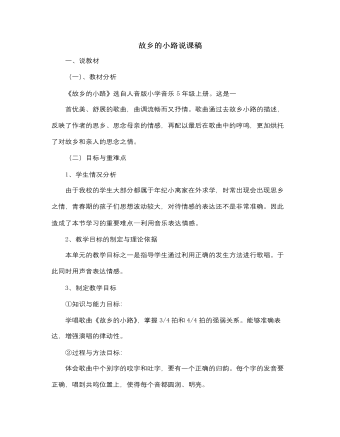
人音版小学音乐五年级上册故乡的小路说课稿
另外,歌曲中的“路”、“福”、“诉”、“咐”、“住”每个字发音要准确,要竖起来,并送到共鸣腔体里,唱到位置上,使每个音都圆润,明亮。4、在处理歌曲情感时,我首先采用了朗读法,学生更能够深切体会音乐的情绪。其次我还采用了画旋律线的方法,让学生能够更直观的感受到歌曲连绵流畅旋律,体验歌曲的情绪是随着音高起伏而变化的。第五环节:拓展延伸这个环节主要是情感的升华,教师设计播放歌曲《月之故乡》以此唤起学生思乡情绪,进行艺术熏陶,感受音乐中的情与美,浅谈自己的感受。第六环节:结束语(小结)通过本课的学习我们学习了3/4拍和4/4拍,掌握了拍子本身的强弱关系。同时学习了变化音#4在歌曲中的演唱技巧。希望我们可以一共去感受作者的思乡之情,同时让我们寻找到另外一种表达情感的方式—歌唱。
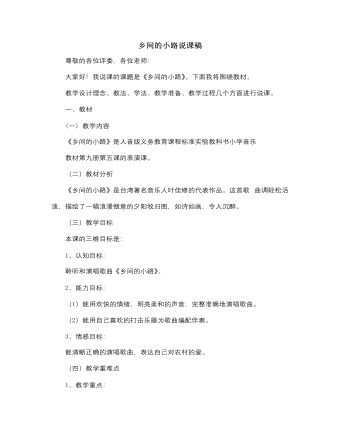
人音版小学音乐五年级上册乡间的小路说课稿
再让学生用“啦”字哼唱歌谱,让学生学会自主学习。跟琴哼唱歌词。结尾句处理(渐弱)注重细节,突出重难点。学会歌曲后做情感处理:在悠扬的音乐声中播放视频乡间的小路,看有哪些景物,对比身处乡间和城市的环境,引导学生用轻松愉快的声音演唱。完整、熟练地演唱歌曲。(轻松富有弹性的声音和高位置唱)。接下来我用竹笛演奏《乡间的小路》,让学生理解、体验和感受不同的乡村风格。 最后让学生带着感情演唱全曲,要注意指导学生体会歌曲的演唱情绪,强调演唱声音要自然、圆润、轻柔。3、表演歌曲学会歌曲后,学生分组,用不同的演唱形式处理歌曲。如:对唱、表演唱、小合唱等。教师对每组的表现做鼓励性评价。让他们“动”起来,并融入到歌曲意境中去,更好的理解歌曲。
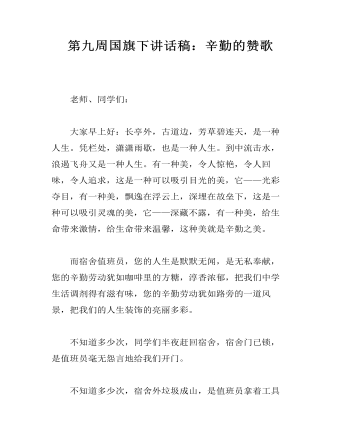
第九周国旗下讲话稿:辛勤的赞歌
老师、同学们:大家早上好:长亭外,古道边,芳草碧连天,是一种人生。凭栏处,潇潇雨歇,也是一种人生。到中流击水,浪遏飞舟又是一种人生。有一种美,令人惊艳,令人回味,令人追求,这是一种可以吸引目光的美,它——光彩夺目,有一种美,飘逸在浮云上,深埋在故垒下,这是一种可以吸引灵魂的美,它——深藏不露,有一种美,给生命带来激情,给生命带来温馨,这种美就是辛勤之美。而宿舍值班员,您的人生是默默无闻,是无私奉献,您的辛勤劳动犹如咖啡里的方糖,淳香浓郁,把我们中学生活调剂得有滋有味,您的辛勤劳动犹如路旁的一道风景,把我们的人生装饰的亮丽多彩。不知道多少次,同学们半夜赶回宿舍,宿舍门已锁,是值班员毫无怨言地给我们开门。不知道多少次,宿舍外垃圾成山,是值班员拿着工具给我们清理。不知道多少次,放假时,值班员送我们的离去,虽然没有说一句话,但那眼神我们每一个人都懂。
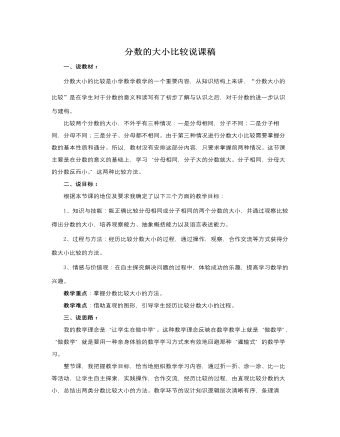
人教版新课标小学数学三年级上册分数的大小比较说课稿
一、说教材:分数大小的比较是小学数学教学的一个重要内容,从知识结构上来讲,“分数大小的比较”是在学生对于分数的意义和读写有了初步了解与认识之后,对于分数的进一步认识与建构。比较两个分数的大小,不外乎有三种情况:一是分母相同,分子不同;二是分子相同,分母不同;三是分子、分母都不相同。由于第三种情况进行分数大小比较需要掌握分数的基本性质和通分。所以,教材没有安排这部分内容,只要求掌握前两种情况。这节课主要是在分数的意义的基础上,学习“分母相同,分子大的分数就大。分子相同,分母大的分数反而小。”这两种比较方法。二、说目标:根据本节课的地位及要求我确定了以下三个方面的教学目标:1、知识与技能:能正确比较分母相同或分子相同的两个分数的大小,并通过观察比较得出分数的大小,培养观察能力、抽象概括能力以及语言表述能力。
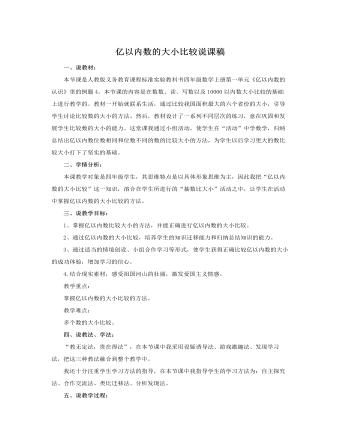
人教版新课标小学数学四年级上册亿以内数的大小比较说课稿
一、说教材:本节课是人教版义务教育课程标准实验教科书四年级数学上册第一单元《亿以内数的认识》里的例题4。本节课的内容是在数数、读、写数以及10000以内数大小比较的基础上进行教学的。教材一开始就联系生活,通过比较我国面积最大的六个省份的大小,引导学生讨论比较数的大小的方法。然后,教材设计了一系列不同层次的练习,意在巩固和发展学生比较数的大小的能力。这堂课我通过小组活动,使学生在“活动”中学数学,归纳总结出亿以内数位数相同和位数不同的数的比较大小的方法,为学生以后学习更大的数比较大小打下了坚实的基础。二、学情分析:本课教学对象是四年级学生,其思维特点是以具体形象思维为主,因此我把“亿以内数的大小比较”这一知识,溶合在学生所进行的“抽数比大小”活动之中,让学生在活动中掌握亿以内数的大小比较的方法。

人教版新课标小学数学五年级上册较复杂的小数乘法说课稿
《较复杂的小数乘法》是第九册第一单元《小数的乘法和除法》的第三节。本 节课的教学内容是教科书第3页的例3、例4。这一教材是在学生学习了小数乘法的意义(小数乘以整数、一个数乘以小数)、小数乘法的计算法则以及小数点位置 移动引起小数大小的变化的基础上进行教学的,它是小数乘法计算法则的引伸和补充,同时也是学生今后进一步学习小数四则混合运算的基础。本节课 的教学目的是:1、使学生进一步掌握小数乘法的计算法则,懂得在点积的小数点时,乘得的积的小数位数不够的,要在前面用0补足;2、使学生初步掌握“当乘 数比1小时,积比被乘数小;当乘数比1大时,积比被乘数大”;3、培养学生的计算能力,自学能力和概括能力。本节课的教学重点是:让学生掌握在定积的小数 时,位数不够的会用0补足。
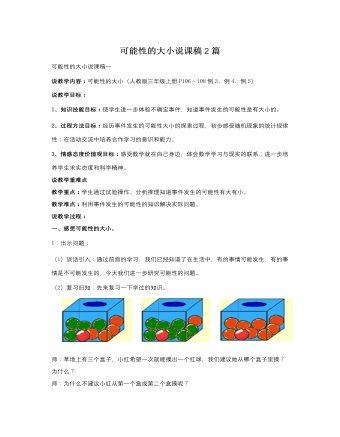
人教版新课标小学数学三年级上册可能性的大小说课稿2篇
说教学内容:可能性的大小(人教版三年级上册P106~108例3、例4、例5)说教学目标:1、知识技能目标:使学生进一步体验不确定事件,知道事件发生的可能性是有大小的。2、过程方法目标:经历事件发生的可能性大小的探索过程,初步感受随机现象的统计规律性;在活动交流中培养合作学习的意识和能力。3、情感态度价值观目标:感受数学就在自己身边,体会数学学习与现实的联系;进一步培养学生求实态度和科学精神。说教学重难点教学重点:学生通过试验操作、分析推理知道事件发生的可能性有大有小。教学难点:利用事件发生的可能性的知识解决实际问题。说教学过程:一、感受可能性的大小。1.出示问题:(1)谈话引入:通过前面的学习,我们已经知道了在生活中,有的事情可能发生,有的事情是不可能发生的,今天我们进一步研究可能性的问题。
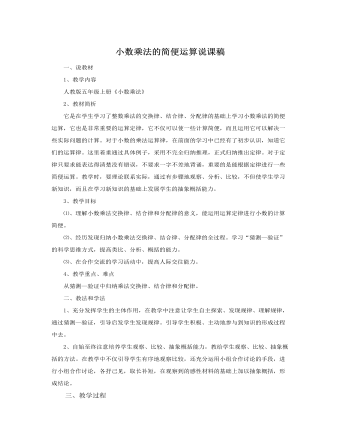
人教版新课标小学数学五年级上册小数乘法的简便运算说课稿
⑴、理解小数乘法交换律、结合律和分配律的意义,能运用运算定律进行小数的计算简便。⑵、经历发现归纳小数乘法交换律、结合律、分配律的全过程。学习“猜测—验证”的科学思维方式,提高类比、分析、概括的能力。⑶、在合作交流的学习活动中,提高人际交往能力。4、教学重点、难点从猜测—验证中归纳乘法交换律、结合律和分配律。二、教法和学法1、充分发挥学生的主体作用,在教学中注意让学生自主探索、发现规律、理解规律,通过猜测—验证,引导启发学生发现规律。引导学生积极、主动地参与到知识的形成过程中去。2、自始至终注意培养学生观察、比较、抽象概括能力,教给学生观察、比较、抽象概括的方法。在教学中不仅引导学生有序地观察比较,还充分运用小组合作讨论的手段,进行小组合作讨论,各抒己见,取长补短,在观察到的感性材料的基础上加以抽象概括,形成结论。
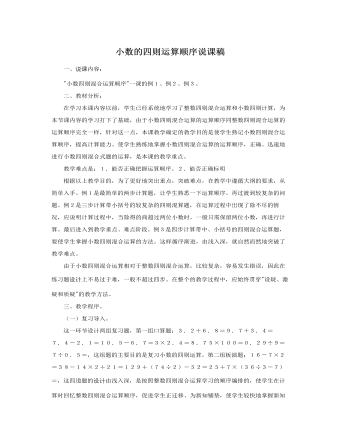
人教版新课标小学数学五年级上册小数的四则运算顺序说课稿
在学习本课内容以前,学生已经系统地学习了整数四则混合运算和小数四则计算,为本节课内容的学习打下了基础,由于小数四则混合运算的运算顺序同整数四则混合运算的运算顺序完全一样,针对这一点,本课教学确定的教学目的是使学生熟记小数四则混合运算顺序,提高计算能力。使学生熟练地掌握小数四则混合运算的运算顺序,正确、迅速地进行小数四则混合式题的运算,是本课的教学重点。教学难点是:1.能否正确把握运算顺序。2.能否正确标明根据以上教学目的,为了更好地突出重点,突破难点,在教学中遵循大纲的要求,从简单入手。例1是最简单的两步计算题,让学生熟悉一下运算顺序。再过渡到较复杂的问题。例2是三步计算带小括号的较复杂的四则混算题,在运算过程中出现了除不尽的情况,应说明计算过程中,当除得的商超过两位小数时,一般只需保留两位小数,再进行计算。最后进入到教学重点、难点阶段。
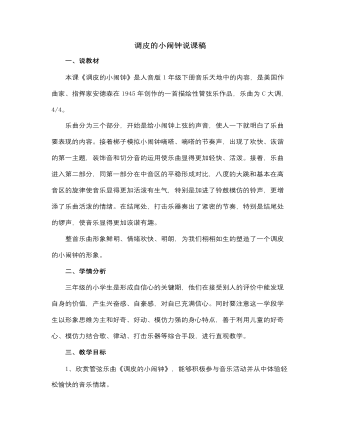
人音版小学音乐一年级下调皮的小闹钟说课稿
首先听A段主题旋律,我启发学生用声势动作、律动等方式参与到音乐中来,让学生展开丰富的想象力,激发学习兴趣进一步感受音乐里调皮的小闹钟形象。然后在通过演唱A段主题旋律,加深对乐曲的主题记忆,为下一环节做铺垫。在B段主题旋律教学中,我引导学生参与音乐体验,引发想象与联想,采用了律动、打击乐器伴奏、声势活动等形式,通过让学生在闹铃声处使用打击乐器伴奏,模仿闹钟铃响参与音乐体验,不断加强学生对音乐主题的理解与记忆更加深了学生对音乐形象的感受,同时也培养了学生的创造力、表现力和良好的合作意识。第四个环节是参与实践,体验音乐有了前面三个环节的“聆听”,接下来就是有拓展地“聆听”。在这一环节不仅体现了学生的表演欲望,同时也锻炼了学生的表演能力。配合多媒体欣赏学生在听音乐主题A、B部分能准确运用律动、歌唱、声势动作、打击乐器伴奏等形式,同时也培养了学生静听音乐的良好习惯,将课堂气氛推向高潮,学生的学习兴趣、自信心、合作能力等都得了很大的提高。
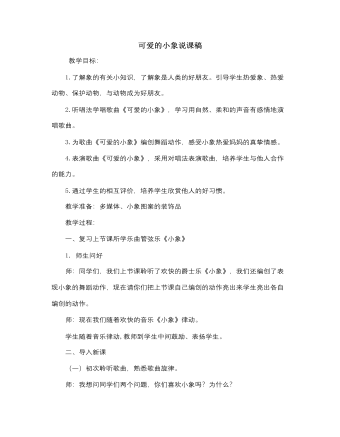
人音版小学音乐一年级下可爱的小象说课稿
师:现在请同学们跟着老师一起朗读歌词。师:我要请两位同学上来,一位同学扮演小朋友,另一位小朋友扮演小象,为我们朗读一次歌词,谁愿意来?学生扮演角色朗读歌词师:你们觉得他们演得好吗?能得多少分?请学生评价,教师总结。(三)编创动作表现歌曲师:如果能加上动作就更好了,现在我们一起来开动脑筋,为这首歌编创动作。在教师的引导下,一句句为歌曲编创动作(四)听唱法学唱歌曲师:我们学会了歌词,还编了动作,当更要学会唱,请同学们跟着老师的琴声学唱歌曲。学生学唱,然后由学生跟着音乐表演歌曲(五)对唱法表演歌曲师:现在我们请1、2组同学扮演小象,3、4组的同学来问小象,我们分角色来表演歌曲。 学生先在原位上演练一遍,然后全体起立,相对而立,表演歌曲。教师作出评价和肯定。三、总结师:今天我们学到了什么学生回答师:今天,我们学习了小象的知识,知道了要与小象成为好朋友,要保护小象和其它动物,学会了表演歌曲《可爱的小象》。
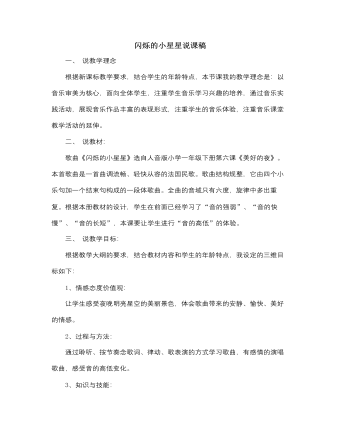
人音版小学音乐一年级下闪烁的小星星说课稿
3、小结:本节课我们听唱了三首不同风格的关于星空的音乐作品,同学们还可以收集更多此类歌曲听一听,感受夜晚星空之美。十、 说板书设计:首先,板书课题时用小星星的图案代替文字,更加吸引学生,容易激发学生的学习兴趣。其次,本节课的板书主要体现乐理知识:反复记号;柯达伊手势图谱。板书目的帮助学生解决学习中的难点。十一、说教学反思:亮点:教师根据学生的身心特点及学习情况有目的、有计划的引导学生进行学习,以达到教学目标。根据学生已有知识,运用柯达伊手势教学法,在准确演唱歌曲的基础上,学唱歌谱,帮助学生建立音高概念,完整的演唱歌曲。成功解决本课教学的难点,完成教学目标。不足之处:教师对于学生律动表演的规则讲解不到位,学生操作不熟练。专业术语使用不到位、不规范,有待于进一步改进和提高。

